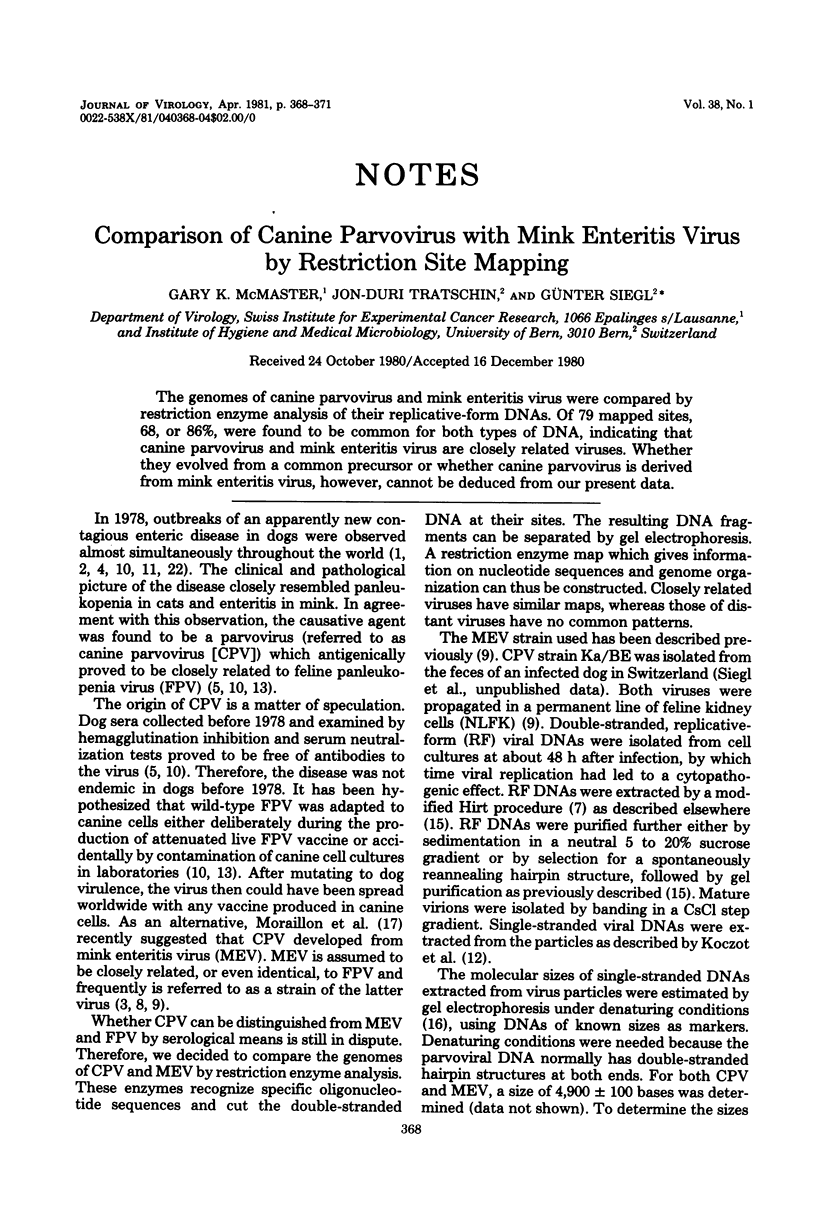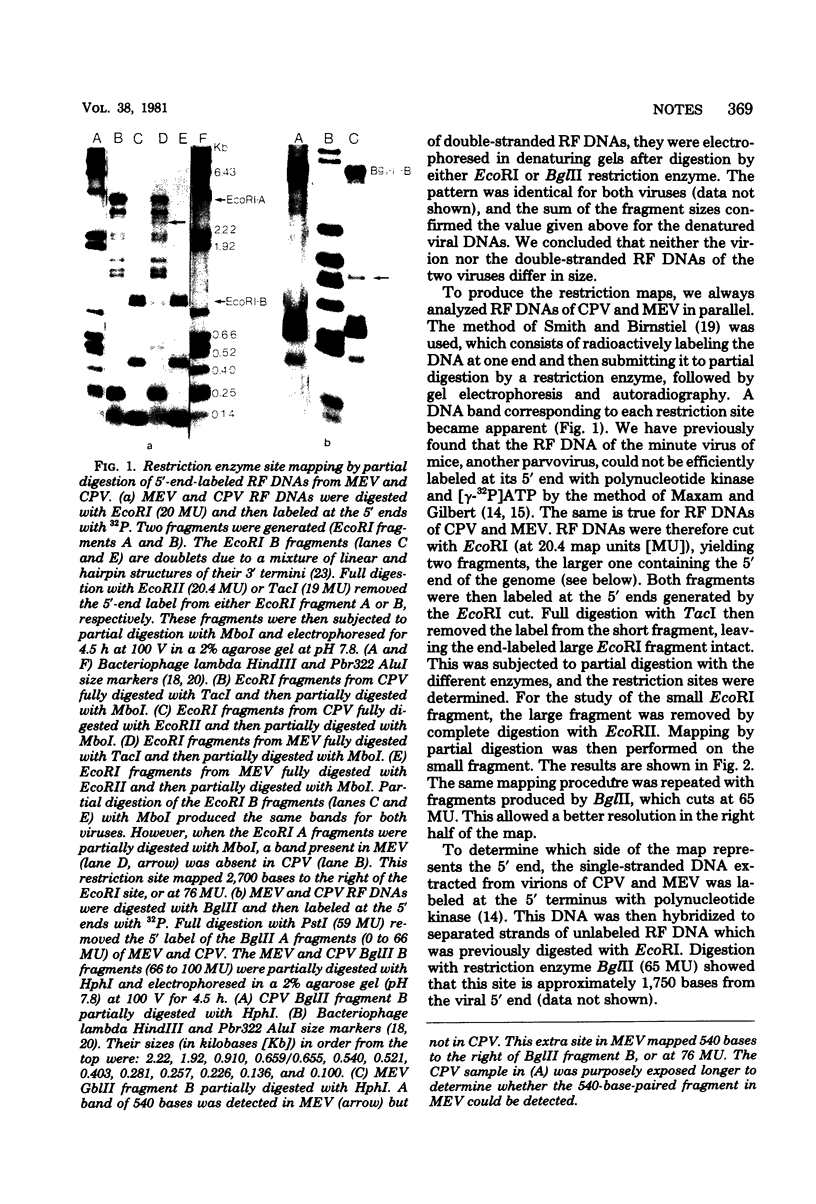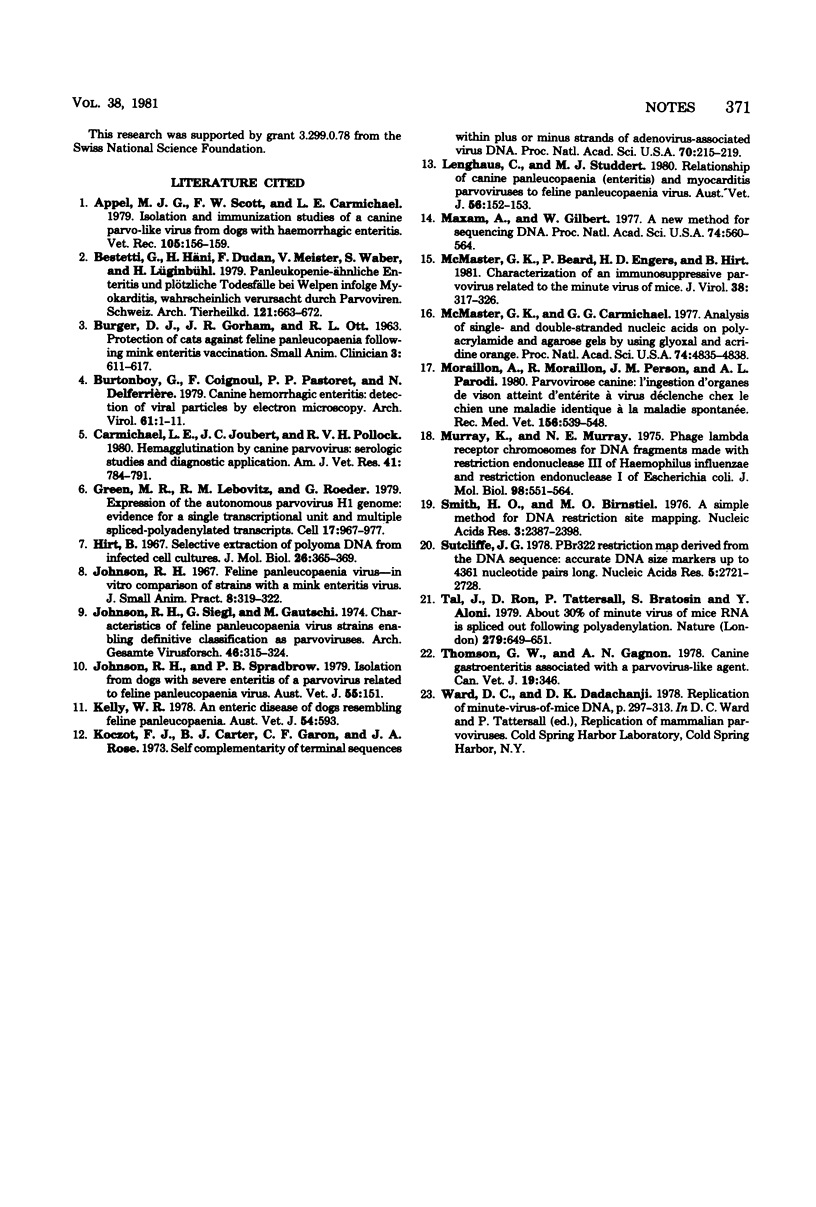Abstract
The genomes of canine parvovirus and mink enteritis virus were compared by restriction enzyme analysis of their replicative-form DNAs. Of 79 mapped sites, 68, or 86%, were found to be common for both types of DNA, indicating that canine parvovirus and mink enteritis virus are closely related viruses. Whether they evolved from a common precursor or whether canine parvovirus is derived from mink enteritis virus, however, cannot be deduced from our present data.
Full text
PDF



Images in this article
Selected References
These references are in PubMed. This may not be the complete list of references from this article.
- Appel M. J., Scott F. W., Carmichael L. E. Isolation and immunisation studies of a canine parco-like virus from dogs with haemorrhagic enteritis. Vet Rec. 1979 Aug 25;105(8):156–159. doi: 10.1136/vr.105.8.156. [DOI] [PubMed] [Google Scholar]
- Bestetti G., Häni H., Dudan F., Meister V., Waber S., Luginbühl H. Panleukopenie-ähnliche Enteritis und plötzliche Todesfälle bei Welpen infolge Myokarditis, wahrscheinlich verursacht durch Parvoviren. Schweiz Arch Tierheilkd. 1979;121(12):663–672. [PubMed] [Google Scholar]
- Burtonboy G., Coignoul F., Delferriere N., Pastoret P. P. Canine hemorrhagic enteritis: detection of viral particles by electron microscopy. Arch Virol. 1979;61(1-2):1–11. doi: 10.1007/BF01320586. [DOI] [PubMed] [Google Scholar]
- Carmichael L. E., Joubert J. C., Pollock R. V. Hemagglutination by canine parvovirus: serologic studies and diagnostic applications. Am J Vet Res. 1980 May;41(5):784–791. [PubMed] [Google Scholar]
- Green M. R., Lebovitz R. M., Roeder R. G. Expression of the autonomous parvovirus H1 genome: evidence for a single transcriptional unit and multiple spliced polyadenylated transcripts. Cell. 1979 Aug;17(4):967–977. doi: 10.1016/0092-8674(79)90336-2. [DOI] [PubMed] [Google Scholar]
- Hirt B. Selective extraction of polyoma DNA from infected mouse cell cultures. J Mol Biol. 1967 Jun 14;26(2):365–369. doi: 10.1016/0022-2836(67)90307-5. [DOI] [PubMed] [Google Scholar]
- Johnson R. H. Feline panleucopaenia virus--in vitro comparison og strains with a mink enteritis virus. J Small Anim Pract. 1967 Jun;8(6):319–324. doi: 10.1111/j.1748-5827.1967.tb04557.x. [DOI] [PubMed] [Google Scholar]
- Johnson R. H., Siegl G., Gautschi M. Characteristics of feline panleucopaenia virus strains enabling definitive classification as parvoviruses. Arch Gesamte Virusforsch. 1974;46(3-4):315–324. doi: 10.1007/BF01240073. [DOI] [PubMed] [Google Scholar]
- Kelly W. R. An enteric disease of dogs reselmbing feline panleucopaenia. Aust Vet J. 1978 Dec;54(12):593–593. doi: 10.1111/j.1751-0813.1978.tb02426.x. [DOI] [PubMed] [Google Scholar]
- Koczot F. J., Carter B. J., Garon C. F., Rose J. A. Self-complementarity of terminal sequences within plus or minus strands of adenovirus-associated virus DNA. Proc Natl Acad Sci U S A. 1973 Jan;70(1):215–219. doi: 10.1073/pnas.70.1.215. [DOI] [PMC free article] [PubMed] [Google Scholar]
- Lenghaus C., Studdert M. J. Relationships of canine panleucopaenia (enteritis) and myocarditis paroviruses to feline panleucopaenia virus. Aust Vet J. 1980 Mar;56(3):152–153. doi: 10.1111/j.1751-0813.1980.tb05663.x. [DOI] [PubMed] [Google Scholar]
- Maxam A. M., Gilbert W. A new method for sequencing DNA. Proc Natl Acad Sci U S A. 1977 Feb;74(2):560–564. doi: 10.1073/pnas.74.2.560. [DOI] [PMC free article] [PubMed] [Google Scholar]
- McMaster G. K., Beard P., Engers H. D., Hirt B. Characterization of an immunosuppressive parvovirus related to the minute virus of mice. J Virol. 1981 Apr;38(1):317–326. doi: 10.1128/jvi.38.1.317-326.1981. [DOI] [PMC free article] [PubMed] [Google Scholar]
- McMaster G. K., Carmichael G. G. Analysis of single- and double-stranded nucleic acids on polyacrylamide and agarose gels by using glyoxal and acridine orange. Proc Natl Acad Sci U S A. 1977 Nov;74(11):4835–4838. doi: 10.1073/pnas.74.11.4835. [DOI] [PMC free article] [PubMed] [Google Scholar]
- Murray K., Murray N. E. Phage lambda receptor chromosomes for DNA fragments made with restriction endonuclease III of Haemophilus influenzae and restriction endonuclease I of Escherichia coli. J Mol Biol. 1975 Nov 5;98(3):551–564. doi: 10.1016/s0022-2836(75)80086-6. [DOI] [PubMed] [Google Scholar]
- Smith H. O., Birnstiel M. L. A simple method for DNA restriction site mapping. Nucleic Acids Res. 1976 Sep;3(9):2387–2398. doi: 10.1093/nar/3.9.2387. [DOI] [PMC free article] [PubMed] [Google Scholar]
- Sutcliffe J. G. pBR322 restriction map derived from the DNA sequence: accurate DNA size markers up to 4361 nucleotide pairs long. Nucleic Acids Res. 1978 Aug;5(8):2721–2728. doi: 10.1093/nar/5.8.2721. [DOI] [PMC free article] [PubMed] [Google Scholar]
- Tal J., Ron D., Tattersall P., Bratosin S., Aloni Y. About 30% of minute virus of mice RNA is spliced out following polyadenylation. Nature. 1979 Jun 14;279(5714):649–651. doi: 10.1038/279649a0. [DOI] [PubMed] [Google Scholar]
- Thomson G. W., Gagnon A. N. Canine gastroenteritis associated with a parvovirus-like agent. Can Vet J. 1978 Dec;19(12):346–346. [PMC free article] [PubMed] [Google Scholar]



